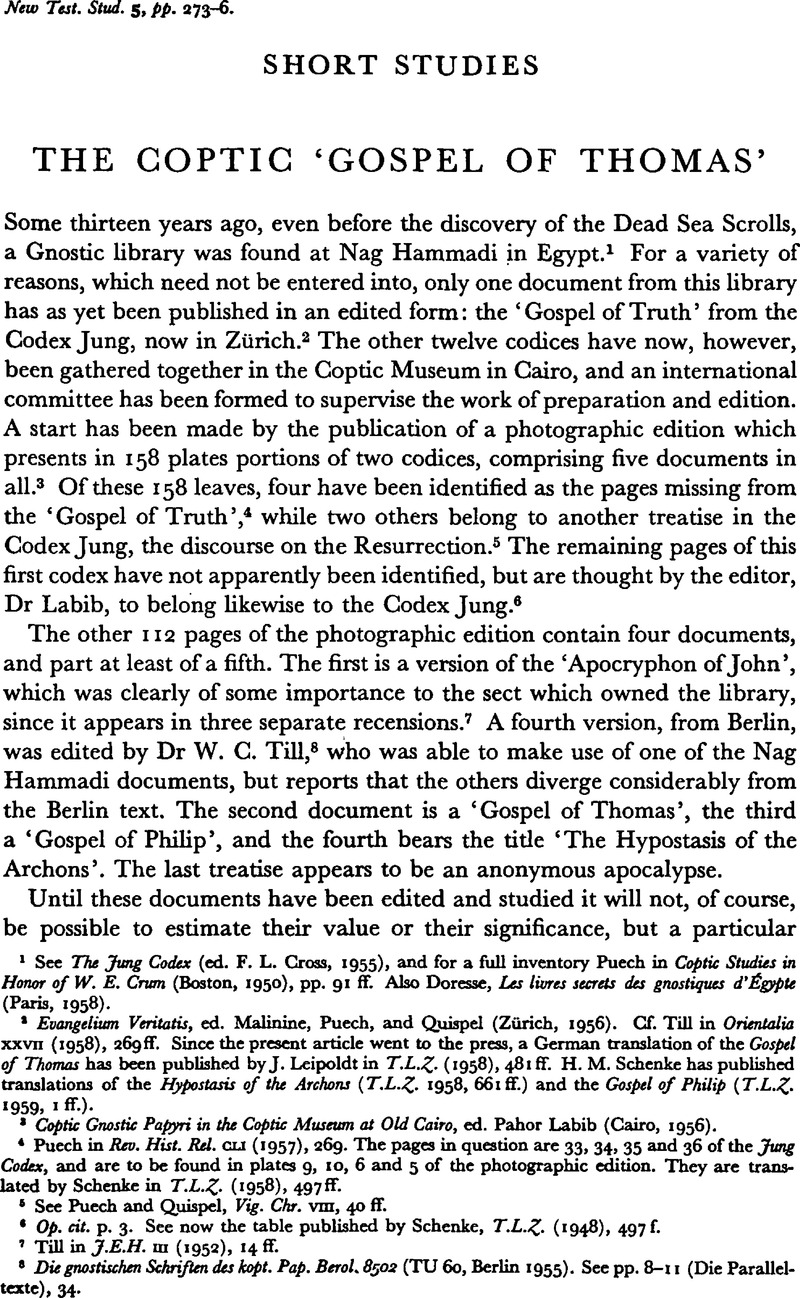No CrossRef data available.
Article contents
The Coptic ‘Gospel of Thomas’
Published online by Cambridge University Press: 05 February 2009
Abstract

- Type
- Short Studies
- Information
- Copyright
- Copyright © Cambridge University Press 1959
References
page 274 note 1 See The Jung Coder (ed. Cross, F. L., 1955),Google Scholar and for a full inventory Puech, in Coptic Studies in Honor of W. E. Crum (Boston, 1950), pp. 91 ff.Google Scholar Also Doresse, , Les livres secrets des gnostiques d'Égypte (Paris, 1958).Google Scholar
page 274 note 2 Evangelium Veritatis, ed. Malinine, , Puech, , and Quispel, (Zürich, 1956).Google ScholarCf. Till, in Orientalia xxvii (1958), 269 ff.Google Scholar Since the present article went to the press, a German translation of the Gospel of Thomas has been published by Leipoldt, J. in T.L.Z. (1958), 481ff.Google ScholarSchenke, H. M. has published translations of the HypostoAs of the Archons (T.L.Z. 1958, 661 ff.) and the Gospel of Philip (T.L.Z. 1959, 1 ff.).Google Scholar
page 274 note 3 Coptic Gnostic Papyri in the Coptic Museum at Old Cairo, ed. Labib, Pahor (Cairo, 1956).Google Scholar
page 274 note 4 Puech, in Rev. Hist. Rel. CLI (1957), 269.Google ScholarThe pages in question are 33, 34, 35 and 36 of the Jung Coder, and are to be found in plates 9, 10, 6 and of the photographic edition. They are translated by Schenke in T.L.Z. (1948), 497ff.Google Scholar
page 274 note 5 See Puech, and Quispel, , Vig. Chr. VIII 40 ff.Google Scholar
page 274 note 6 Op. cit. p. 3.Google Scholar See now the table published by Schenke, , T.L.Z. (1948), 497f.Google Scholar
page 274 note 7 Till, in J.E.H. III (1952), 14ff.Google Scholar
page 274 note 8 Die gnostischen Schriflen des kopt. Pap. Berol. 8502 (TU 60, Berlin 1955). See pp. 8–11 (Die Paralleltexte), 34.Google Scholar
page 275 note 1 Jung Codex, pp. 21 f.Google Scholar
page 275 note 2 Grenfell, and Hunt, , The Oxyrhynchus Papyri, part IV (1898), part iv (1904). See their discussion of the problems, part IV, pp. 10–22.Google Scholar
page 275 note 3 Le Muséon, LXX (1957), 59 ff.Google Scholar German translation of whole text now in T.L.Z. (1958), 481 ff.Google Scholar
page 275 note 4 Ibid. pp. 307 ff. Cerfaux notes certain similarities to the ‘Gospel of Truth’, and concludes ‘noun ne pourrions absoudre le vieil auteur qui a collectionné les “paroles secretes” d'une certaine complaisance pour les théories tie gnose valentinienne’ (op. cit. p. 327). In this connection it may be recalled that Grenfell and Hunt held that the second saying of Ox. P. 654 ‘if “Gnostic”, presents a very primitive kind of Gnosticism’ (part iv, p. 12) and that van Unnik has argued that the ‘Gospel of Truth’ reveals the Valentinian theory at a very primitive stage in its development (Jung Codex, p. 104).
page 275 note 5 Grenfell and Hunt noted a lacuna at the foot of the recto of Ox. P. I, which ‘may have extended to five or even ten lines’ (part 1, p. 1). Garitte observes that if the Greek was as long as the Coptic the lacuna must have extended to about seventeen lines (op. Cit. p. 70, n. 5).
page 276 note 1 Part iv, p. 1.Google Scholar
page 276 note 2 Since this note went to the press a better reconstruction of the first two lines has been proposed by Puech, (C.R. Acad. Inscr. et Belles Lettres, 1957, Paris, 1958, p. 153), but even so the correspondence is not yet quite complete.Google Scholar
page 276 note 3 Grenfell and Hunt, part iv, pp. 4f;Google Scholarcf. Garitte, op. cit. p. 69. n. 2.Google Scholar
page 276 note 4 Ibid. 5. ![]() in the above reconstruction is guaranteed by the Coptic (Garitte, op. cit. p. 69).
in the above reconstruction is guaranteed by the Coptic (Garitte, op. cit. p. 69).
page 276 note 5 Garitte, op. cit. p. 69, n. 1.Google Scholar
page 276 note 6 Vig. Chr. XI (1957), 189 ff.Google Scholar
page 276 note 7 Ibid. 194. Quispel (ibid. p. 189) regards the saying referred to above as ‘simply a quotation from the lost Gospel according to the Hebrews’. Another quotation occurs in the Coptic Gospel of May (Quispel in Vig. Chr. XI (1957), 139 ff.).Google Scholar




